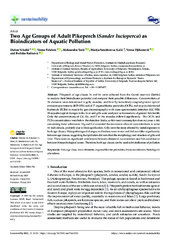Приказ основних података о документу
Two Age Groups of Adult Pikeperch ( Sander lucioperca ) as Bioindicators of Aquatic Pollution
| dc.creator | Nikolić, Dušan | |
| dc.creator | Poleksić, Vesna | |
| dc.creator | Tasić, Aleksandra | |
| dc.creator | Smederevac-Lalić, Marija | |
| dc.creator | Djikanović, Vesna | |
| dc.creator | Rašković, Božidar | |
| dc.date.accessioned | 2023-09-20T11:31:54Z | |
| dc.date.available | 2023-09-20T11:31:54Z | |
| dc.date.issued | 2023 | |
| dc.identifier.issn | 2071-1050 | |
| dc.identifier.uri | https://econpapers.repec.org/article/gamjsusta/v_3a15_3ay_3a2023_3ai_3a14_3ap_3a11321-_3ad_3a1198759.htm | |
| dc.identifier.uri | http://aspace.agrif.bg.ac.rs/handle/123456789/6415 | |
| dc.description.abstract | Pikeperch of age classes 3+ and 4+ were collected from the Garaši reservoir (Serbia) to analyze their bioindicator potential and compare their possible differences. Concentrations of 26 elements were determined in gills, muscles, and liver by inductively-coupled plasma optical emission spectrometry (ICP-OES) and of 17 organochlorine pesticides (OCPs), and six polychlorinated biphenyls (PCBs) in muscle by gas chromatography with mass spectrometric detection (GC-MS). Histopathological changes in the liver and gills were analyzed as biomarkers of general fish health. Only the concentrations of Cd, Na, and P in the muscles differed significantly. The OCPs and PCBs concentrations were below the detection limits, so fish meat consumption does not pose a risk concerning these substances. Hg and Cd exceeded the maximum allowed concentrations in some 4+ individuals, probably due to biomagnification. Gills were the most affected by metal exposure in both age classes. Histopathological changes and indices were minor and did not differ significantly between age classes, suggesting that pollution did not affect the morphology and structure of gills and liver. There were no significant correlations between elemental accumulation and fish condition or between histopathological scores. Therefore, both age classes can be used as bioindicators of pollution. | |
| dc.relation | info:eu-repo/grantAgreement/MESTD/inst-2020/200053/RS// | |
| dc.relation | info:eu-repo/grantAgreement/MESTD/inst-2020/200116/RS// | |
| dc.relation | info:eu-repo/grantAgreement/MESTD/inst-2020/200007/RS// | |
| dc.relation | info:eu-repo/grantAgreement/MESTD/inst-2020/200030/RS// | |
| dc.rights | openAccess | |
| dc.rights.uri | https://creativecommons.org/licenses/by/4.0/ | |
| dc.source | Sustainability | |
| dc.source | Sustainability | |
| dc.subject | age class | |
| dc.subject | bioaccumulation | |
| dc.subject | fish | |
| dc.subject | histological alterations | |
| dc.subject | organochlorine pesticides | |
| dc.subject | toxic elements | |
| dc.title | Two Age Groups of Adult Pikeperch ( Sander lucioperca ) as Bioindicators of Aquatic Pollution | |
| dc.type | article | en |
| dc.rights.license | BY | |
| dc.citation.epage | 13 | |
| dc.citation.issue | 14 | |
| dc.citation.rank | M23~ | |
| dc.citation.spage | 1 | |
| dc.citation.volume | 15 | |
| dc.identifier.fulltext | http://aspace.agrif.bg.ac.rs/bitstream/id/24763/Two_Age_Groups_pub_2023.pdf | |
| dc.identifier.rcub | https://hdl.handle.net/21.15107/rcub_agrospace_6415 | |
| dc.type.version | publishedVersion |


